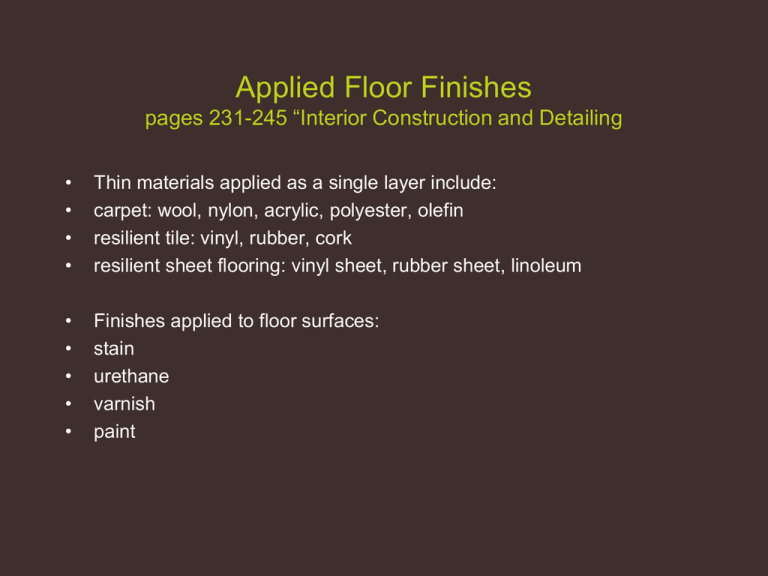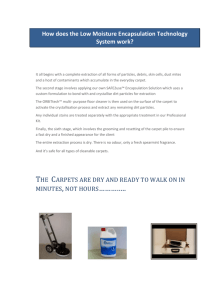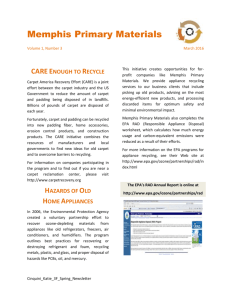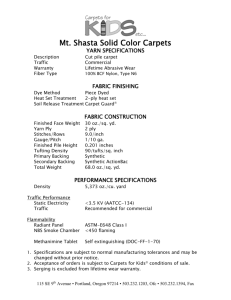Applied Floor Finishes pages 231-245 “Interior Construction and
advertisement

Applied Floor Finishes pages 231-245 “Interior Construction and Detailing • • • • Thin materials applied as a single layer include: carpet: wool, nylon, acrylic, polyester, olefin resilient tile: vinyl, rubber, cork resilient sheet flooring: vinyl sheet, rubber sheet, linoleum • • • • • Finishes applied to floor surfaces: stain urethane varnish paint Concrete floor stain colors and hardwood floor with a urethane finish. Carpet: used in three different forms: sheet carpet, carpet tiles, and rugs. • Sheet carpet: commonly manufactured in 12’ wide rolls. • Carpet tiles are individual squares of carpet, typically 24”x24”, 18”x18”, and 12”x12”. • Rugs are soft floor coverings laid on the floor but not attached to it. Carpet tiles Rugs Native American handwoven rugs: Navajo Native American weavers A loom can be a very simply constructed device that can be used to produce stunningly beautiful rugs Small Looms Sheet carpet • Fiber Performance in Carpet • • • • • • • • • Fiber Strength Appearance Retention Stain Resistant* Soil Resistant** Cleaning Very Good Available Colors Pilling & Fuzzing Resistance to Cleaners Nylon (filament) Nylon (staple) Olefin (filament) Polyester (staple) Wool (staple) Excellent Excellent Very Good Very Good Very Good Excellent Excellent Very Good Excellent Fair Excellent Fair Good Fair Very Good Excellent Excellent Excellent Very Good Very Good Very Good Excellent Fair Very Good Excellent Fair Very Good Good Very Good Very Good Fair Very Good Good Excellent Very Good Very Good Fair Fair Good The following text is taken from: http://www.madehow.com/Volume-2/Carpet.html • Carpet is a textile floor covering that is distinguished from the more general term "rug" by being fixed to the floor surface and extending wall to wall. • The first carpets of note were woven by nomads. The thick carpets were easy to transport and were placed over the sand floor of tent dwellings. Early looms were similarly easy to transport. • The first carpet factory in the U.S. was built by William Sprague in Philadelphia in 1791. His looms, based on English inventions, could make 27-inch (69-cm) runners that could be sewn together to make larger carpets. By 1800, 6-8 yards (7-9 m) of carpet could be made in a day. • Erastus Bigelow built a mill in 1825 in Clinton, Massachusetts, and invented the power loom in 1839, which doubled carpet production. He also invented the first broadloom in 1877. Power looms improved over the years; soon one loom could make 75 yards (82 m) of high quality carpet a day. • Carpet production changed dramatically at the beginning of the 20th century, beginning inauspiciously with a burst of tufted bedspread production in Dalton, Georgia, led by young entrepreneur Catherine Evans Whitener. Tufting is the process of punching yarn into a ground fabric to create many uncut loops at a very fast pace. Tufted bedspread factories dominated the Dalton area by World War II, and they soon began producing tufted rugs as well. • Today, carpet makes up 72% of all flooring, with tufted carpet being 91.5% of production, and the city of Dalton is responsible for over 70% of the world's production of carpet. • Carpet consists of dyed pile yarns; a primary backing in which the yarns are sewn; a secondary backing that adds strength to the carpet; adhesive that binds the primary and secondary backings; and, in most cases, a cushion laid underneath the carpet to give it a softer, more luxurious feel. • Ninety-seven percent of pile yarns today are made up of synthetic polymers; the rest of the yarns are wool and comprise the more expensive, woven carpet. Synthetics are plastics such as nylon (which is in 66% of all carpet), acrylics (15%), polyester (less than 15%), and polypropylene (less than 5%). These pile yarns are dyed using a variety of organic chemical compounds, or occasionally, organometallic complexes. • Most states require a flammability test. A prepared 9 × 9 inch (23 × 23 cm) specimen is placed on a steel plate that has a hole 8 inches (20 cm) in diameter in its middle. A methenamine tablet is ignited in the center. If the charred portion in seven out of eight trials does not reach to the circumference of the hole, the carpet passes. Another important test determines the carpet's resistance to wear. A specimen of carpet is placed in a drum and beaten with a steel ball that has rubber studs on it for 20,000 to 50,000 revolutions. The carpet should look fairly new after this test. To test how the carpet's color stands up to sunlight, a standard light source that simulates sunlight is directed at a specimen, which is then rated according to the number of units of exposure required to produce visible loss of color. Fiber Types and Characteristics • • • • • • • • • • • • Nylon Fiber-forming substance of any long-chain, synthetic polyamide having recurring amide groups as an integral part of the polymer chain. First used in 1959 in carpet. Used in residential and commercial applications. Produced as a solution-dyed fiber or white yarn to-be-dyed. Accounts for 65% of all face fibers in carpet. Durable, resilient, abrasion-resistant. Versatile in coloration possibilities. Favorably priced. Must be treated to be stain and soil resistant Polyester • • • • • • • Made from terephthalic acid and ethylene glycol. Offered primarily as a staple product, although some BCF in being produced. ‘staple’ fibers are short, 6” - 7” long fibers that are spun together to make a long continuous fiber. ‘BCF’, continuous filament, is a continuous filament manufactured as one very long string. these are twisted and heat set to make yarn. Used in residential and commercial applications. 100% of Mohawk's Staple Polyester is PET Polyester, manufactured from recycled plastic bottles. Color clarity Colorfastness Resistant to water-soluble stains. Noted for luxurious "hand Polypropylene (Olefin) • Fiber-forming substance of any long-chain synthetic polymer composed of at least 85%, by weight, of ethylene, propylene, or other olefin units. • Offered primarily as BCF (bulked continuous filament) with some staple product available. Primarily sold as solution-dyed or pre-dyed fiber. Can be engineered for outdoor applications. Resists fading. Inherently stain resistant. Limited color selection. Generates low levels of static electricity. Chemical, moisture, and stain resistant. Favorably priced • • • • • • • These synthetic materials come from... One barrel of oil produces: Wool comes from ... Wool • • • • • • • • Natural fiber. Offered as staple yarn. Luxurious "hand" Durable Inherent resilient property Scaly character of fiber scatters light and reduces visible soil. Largely self-extinguishing when burned. Will char rather than melt and drip Generally expensive Sheet carpet installation: direct glue down: capet is glued directly to the sub-floor material. Carpet pads • foam cushions • rubber cushions: – waffled, flat • fiber cushions: – natural fibers: felt, jute (like rope fibers) – synthetic fibers: nylon, polyester, acrylics, polypropylene Carpet tack strips: typically used in residential installations Carpet manufacturing: methods, materials, locations Carpet looms and methods of manufacturing carpet Tufted carpet • • • Tufted carpet is produced on machines similar to sewing machines. • The yarn is caught by loopers and held in place for loop-pile carpet or cut by blades for cut-pile carpet. • Next, a secondary backing, usually polypropylene, is laminated with latex to the carpet. Several hundred needles stitch hundreds of rows of pile yarn tufts through a backing fabric called the primary backing. Woven carpet • Woven carpet is created on looms that take face and backing yarns and simultaneously weave them into a complete product. • A latex back coating is usually applied for stability and a separate carpet cushion is usually used, although other attached cushions are available for various performance needs. • Principal variations of woven carpet include velvet, Wilton, and Axminster. Mohawk is a large manufacturer of carpet. Their website offers clear explanations of different types of carpet. • www.mohawk-flooring.com/ Tandus is a large carpet manufacturing company. Tandus.com






